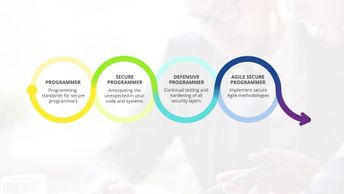Final Exam: Secure Programmer - apply C# secure coding to combat common code vulnerabilities
- apply JavaScript secure coding to combat SQL Injection Vulnerability
- code against buffer overflow attacks in C#
- code against buffer overflow attacks in Java
- code against buffer overflow attacks in Java - part 2
- code against buffer overflow attacks in Java - part 3
- code against buffer overflow attacks in JavaScript
- code against buffer overflow attacks in Python
- code against cross-site scripting attacks in C#
- code against cross-site scripting attacks in Java
- code against cross-site scripting attacks in JavaScript
- code against cross-site scripting attacks in JavaScript - part 2
- code against cross-site scripting attacks in Python
- code against format string attacks in C#
- code against format string attacks in Java
- code against format string attacks in Python
- code against password cracking attacks in JavaScript
- code against password cracking attacks in JavaScript - part 2
- code against SQL injection attacks in C#
- code against SQL injection attacks in C# - part 2
- code against SQL injection attacks in Java
- code against SQL injection attacks in Java - part 2
- code against SQL injection attacks in JavaScript
- code against SQL injection attacks in Python
- code against SQL injection attacks in Python - part 2
- describe and be able to avoid common programming errors that can undermine the security
- describe and use CVE vulnerability scoring
- describe and use threat models including STRIDE, PASTA, DREAD, and SQUARE
- describe asymmetric algorithms including RSA, ECC, and Diffie-Helman
- describe authentication and authorization, including models such as DAC, MAC, RBAC, and ABAC
- describe hashing algorithms such as MD5 and SHA as well as MAC and HMAC
- describe OWASP Top 10 vulnerabilities
- describe OWASP Top 10 vulnerabilities including broken access control, security misconfiguration, sensitive data exposure, and insufficient attack protection
- describe OWASP Top 10 vulnerabilities including cross-site request forgery, using components with known vulnerabilities, and underprotected APIs
- describe OWASP Top 10 vulnerabilities including SQL injection, broken authentication, and cross-site scripting
- describe secure programming verification and validation process and techniques
- describe security concepts, including the CIA triangle, least privileges, and separation of duties
- describe specific security vulnerabilities and recognize how to program counter techniques
- describe symmetric algorithms including AES, Blowfish, and Serpent
- describe the resiliency concepts such as stability, recovery, and defensive coding
- identify OWASP Top 10 vulnerabilities including broken access control, security misconfiguration, sensitive data exposure, and insufficient attack protection
- identify OWASP Top 10 vulnerabilities including cross-site request forgery, using components with known vulnerabilities, and underprotected APIs
- identify security concepts, including the CIA triangle, least privileges, and separation of duties
- identify symmetric algorithms including AES, Blowfish, and Serpent
- identify the resiliency concepts such as stability, recovery, and defensive coding
- implement C# secure coding to combat common code vulnerabilities
- implement JavaScript secure coding to combat Cross-Site Scripting attacks
- implement JavaScript secure coding to combat SQL Injection Vulnerability
- implement Java secure coding to combat SQL Injection Vulnerability
- implement Python secure coding to combat a variety of security vulnerabilities
- recognize OWASP Top 10 vulnerabilities including broken access control, security misconfiguration, sensitive data exposure, and insufficient attack protection
- recognize specific security vulnerabilities and recognize how to program counter techniques
- use CVSS scoring for vulnerabilities
- use OWASP Zap vulnerability scanner to test web sites for common vulnerabilities
- use Vega Vulnerability Scanner to test web sites for common vulnerabilities
- write resilient C# code
- write resilient Java code
- write resilient Java code - part 2
- write resilient JavaScript code
- write resilient Python code
|


